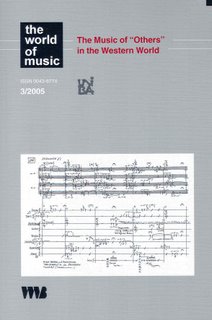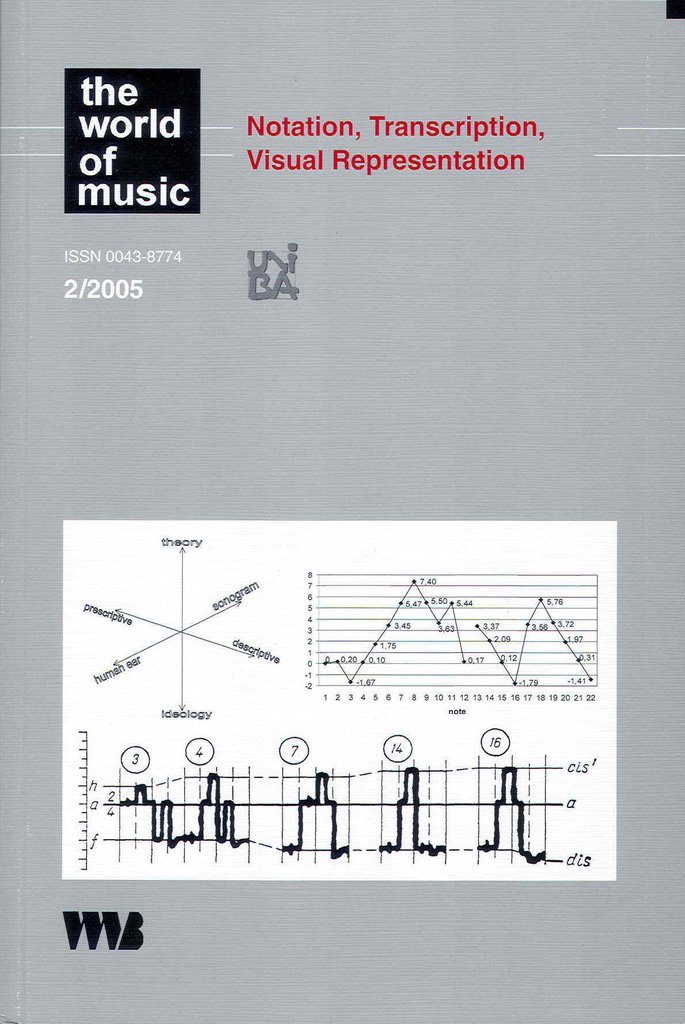wom 49, 2007-3
Music and Politics on the Korean Peninsula

Editor: Max-Peter Baumann
Co-Editor: Jonathan P. J. Stock
Guest Editors: Nathan Hesselink
ISSN 0043-8774
ISBN-978-3-86135-813-8
CONTENTS
Max Peter Baumann From the Editor
Articles
Nathan Hesselink
Music and Politics on the Korean Peninsula (Introduction)
Robert C. Provine
Music, Measurements, Pitch Survivals, and Bell Shapes in Korea
Nam Sang-sook
The Debate over the Distortion of Chongmyo Cheryeak
Roald Maliangkay
Their Masters’ Voice: Korean Traditional Music SPs (Standard Play Records) under Japanese Colonial Rule
Nathan Hesselink
Taking Culture Seriously: Democratic Music and Its Transformative Potential in South Korea
Kwon Ohsung
The Re-formation of Traditional Folksongs in North Korea
Book Reviews (Helena Simonett, ed.)
Thomas Burkhalter
Ines Weinrich, Fayruz und die Brüder Rahbani: Musik, Moderne und Nation im Libanon
Chris Goertzen
Erynn Marshall, Music in the Air Somewhere: The Shifting Borders of West Virginia’s Fiddle and Song Traditions
Maria Williams
Michael Pisani, Imagining Native America in Music
Andrew G. Wood
Jocelyne Guilbault, Governing Sound: The Cultural Politics of Trinidad’s Carnival Music
Jason Toynbee
Wendy Fonarow, Empire of Dirt: The Aesthetics and Rituals of British Indie Music
Ciro Lo Muzi
Pia Srinivasan, Il raga che porta la pioggia
João Junqueira
Martha Ulhôa and Ana Maria Ochoa, Música Popular na América Latina: Pontos de Escuta
Recording Reviews (Dan Bendrups, ed.)
Jesse Samba Wheeler
In the Blood: Portrait of a Griot directed by Aleksi Oksanen and Jari Järvi, produced by Kaarna Productions, DVD
Nino Tsitsishvili
Funeral Chants from the Georgian Caucasus by Hugo Zemp, Collection Süpor Xao, DVD
Joseph S. Kaminski
An African Brass Band by Hugo Zemp, Collection Süpor Xao, DVD
Aleksi Oksanen
Siaka, an African Musician by Hugo Zemp, Collection Süpor Xao, DVD
Abstracts
Music and Politics on the Korean Peninsula
Nathan Hesselink
The collection of essays in this volume moves forward from the position that music and politics are always inextricably linked. The modern conceit of autonomous art fails to account for the historical and cultural embeddedness of music, that its creation and performance exist within overlapping spheres of economics, social status, political control, religious practice, and public reception. Music is also realized within specific spaces—each with their own semantically laden histories and uses—and that performances always have an audience, the act of listening itself contingent on appropriation, control, and the construction of meaning. Music as embodied, performative art is an essentially social entity, snared within webs of relationships between patrons, rulers, composers, performers, audiences, and technology. That the musical worlds of the East and West could be conceptualized as separate (but increasingly interacting) universes during much of the twentieth century belies their remarkably similar foundations. For both ancient Greek theorists and early Confucian scholar-officials, music was the arena in which the proper balance between mankind, the state, and the broader world was checked and regulated. A concern with numbers, ratios, cosmology, and ideas related to beauty were as much passions of the Pythagoreans as they were early Chinese ritual specialists. And while music and politics were comfortable bedfellows in both of these societies more than two millennia ago, in East Asia—here focusing on the Korean peninsula—such a heightened sensitivity to music’s social and spiritual properties and energies maintained an explanatory power much longer than it did in the West, at least on the official governmental level. What this collection of essays will illustrate in dramatic manner is the seriousness with which music was and continues to be taken within political contexts that is frankly quite surprising to those unfamiliar with the Korean experience.
Music, Measurements, Pitch Survivals, and Bell Shapes
in Korea
Robert C. Provine
The young Chosn dynasty court, in keeping with long-standing Chinese Confucian tradition, needed to establish in the early fifteenth century a new set of standardized measurements (length, weight, and volume) for use in the kingdom. The measurements were all proportionately related, so that if one were fixed, all the others were also thereby determined. Following Chinese precedent, the Koreans did considerable research into the establishing of a fundamental musical pitch from which the other twelve pitches in the musical system could be determined, and the length of the pitch pipe which produced this fundamental pitch in turn constituted a basic unit of length from which the other standard measurements could be calculated.
The Debate over the Distortion of Chongmyo Cheryeak
Nam Sang-sook
Chongmyo cheryeak as performed today is quite different from that shown in the musicbooks of the Chosyn dynasty. Varied note values, rhythmic cycles, pak cues marking text lines, and traditional Korean instruments, the gayago, the geomungeo, and the Korean bipa—none of these are to be found in today’s version. Pak cues in the middle of lines now obscure the meaning of the text that is the core of ceremonial music. Rhythmic patterns, or jangdan, that are the most important element in Korean traditional music have been rendered invalid by a one-tone-per-beat structure. The 3-2-3 arrangement of jeonggan (boxes of notation) as based upon the yin-yang principle has also disappeared. This article argues that these changes were made for the purposes of distortion during the Japanese colonial rule, and that claims of natural change are without foundation.
Their Masters’ Voice: Korean Traditional Music SPs (Standard Play Records) under Japanese Colonial Rule
Roald Maliangkay
Researchers in Korean studies looking into the popular entertainment industries during the colonial period have historically focused on cultural nationalism or economic prowess. Studies of music from this period that are not primarily concerned with aspects of resistance or censorship have come out only in the last few years, and so it is only recently that the popularity of the many new forms of entertainment among Koreans at the time has come to be recognized. In this article I describe the interaction of Koreans and Japanese in these industries from the time of their inception around the turn of the nineteenth century, and relate how politics on the one hand, and the influence of technology on the other, changed both the sound and concept of recorded Korean music until the late 1930s. In doing so, I focus on recordings of traditional music and refute the idea that the Japanese tried to indiscriminately manipulate them from the outset.
Taking Culture Seriously: Democratic Music and Its Transformative Potential in South Korea
Nathan Hesselink
This article outlines my personal search for a working theory of democratic music in the context of South Korean folk drumming and dance (p’ungmul). Motivated by the call of Korean political theorists and folklorists of the late twentieth century for the identification and investigation of democratic elements within traditional culture, I attempt to locate such ideals in the musical structure and performance practices of an indigenous drumming tradition. Through an extensive review of the pertinent literature, I was able to identify five general principles of musical democracy that are consistent with established democratic theory. My analysis hopes to highlight the ways in which we can move beyond discussions of performative art in purely aesthetic terms, revealing the socially transformative potential of the artistic realm.
Content Summary & Abstracts






